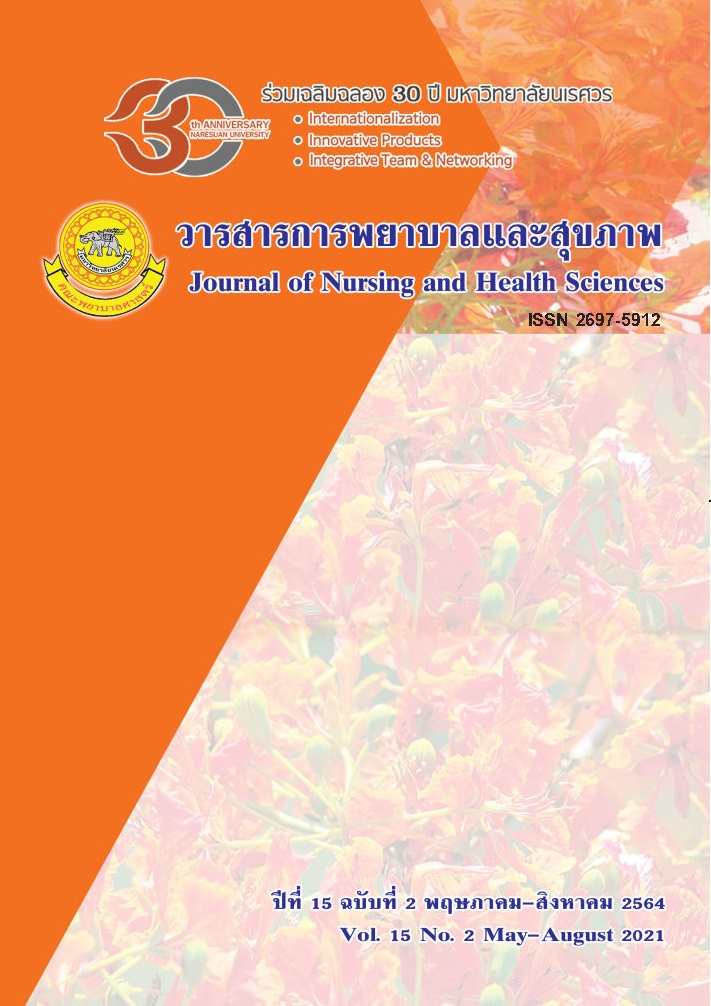An Infant with Lipomyelomenigocele: A case study and Nurses’ Roles
Main Article Content
Abstract
Lipomyelomenigocele is rarely occurred in neonates; however, it is complicated abnormality and leads to consequences of neurological functions regarding to the controls of elimination and leg movement. Lipomyelomenigocele is a congenital abnormality in neurological system which has lipoma attached to spinal cords that have not yet closed. Physical examination usually revealed abnormal lumps in the subcutaneous layer on the middle of the back. When infants have grown up and the treatment is not provided, infants will introduce signs of the tethered cord syndrome. Diagnosis of Lipomyelomenigocele requires clinical signs and symptoms as well as the results of ultrasound and magnetic resonance imaging (MRI). The specific report of ultrasound and MRI elucidates lumps of lipoma on the back that communicated through the spinal canal and attached to the spinal cord.The occurrence of Lipomyelomenigocele often affects the nervous system functions regarding the controls of leg movement, urinary, and excretory systems. Surgical procedures are the most common treatment which used to remove fatty masses from nerves and suture to close vertebraes that have not yet closed.Nurses have important roles to provide nursing caring for patients during hospitalization for both in monitoring preoperative and postoperative potential complications. These nursing implications aim to diminish neurological complications and enhance infants to grow up with optimal quality of life based on their developmental mile stone.
Article Details

This work is licensed under a Creative Commons Attribution-NonCommercial-NoDerivatives 4.0 International License.
References
Feldstein, N. A. & Reid, P. C. (2021). Lipomyelomeningocele. Retrieved 1 July 2021 from https://www.columbiaspine.org/condition/lipomyelomeningocele/
Goodrich, D. J., Patel, D., Loukas, M., Tubbs, R. S., & Oakes, W. J. (2016). Symptomatic retethering of the spinal cord in postoperative lipomyelomeningocele patients: a meta-analysis. Childs Nerv Syst, 32(1), 121-126. https://doi.org/10.1007/s00381-015-2839-7
Iamphonrat, T., Thirapatarapong, W., & Pajareya, K. (2016). Clinical characteristics of patients with myelomeningocele at Siriraj Hospital during 2011-2012. Journal of Rehabilitation Medicine, 26(3): 104-110.
Jensen, A. (2012). Nursing care and surgical correction of neonatal myelomeningocele. Infant, 8(5), 142-146.
Johri, M., Subramanian, S. V., Sylvestre, M.-P., Dudeja, S., Chandra, D., Koné, G. K., . . . Pahwa, S. (2015). Association between maternal health literacy and child vaccination in India: a cross-sectional study. Journal of Epidemiology and Community Health, 69, 849-857. doi:10.1136/jech-2014-205436
Malcolm, W. F. (2015). Neural Tube Defects. In Beyond the NICU: Comprehensive Care of the High-Risk Infant. New York, NY: McGraw-Hill Education.
Morota, N., Ihara, S., & Ogiwara, H. (2017). New classification of spinal lipomas based on embryonic stage. 19(4), 428. doi:10.3171/2016.10.Peds16247
Sarmento-Gonçalves, I., Cunha, M., Loureiro, T., Pinto, P. S., & Ramalho, C. (2019). Fetal lipomyelomeningocele: A closed neural tube defect diagnosed at second-trimester ultrasound examination. 47(3), 169-171. doi:10.1002/jcu.22662
Sarris, C. E., Tomei, K. L., Carmel, P. W., & Gandhi, C. D. (2012). Lipomyelomeningocele: pathology, treatment, and outcomes. 33(4), E3. doi:10.3171/2012.7.Focus12224
Singh, A., Ghosh, S., Chaudhuri, A., Sadique, S., & Chaudhuri, S. (2018). Lipomyelomeningocele—Controversies in Management. Indian Journal of Neurosurgery, 07(01), 005-007. https://doi.org/10.1055/s-0038-1649525
Vitayaburananont, P., & Chotisukarat, H. (2016). Pediatric pain. Vajira Medical Journal: Journal of Urban Medicine, 60(2), 135-145.
Vora, T. K., Girishan, S., Moorthy, R. K., & Rajshekhar, V. (2021). Early- and long-term surgical outcomes in 109 children with lipomyelomeningocele. Childs Nerv Syst, 37(5), 1623-1632. https://doi.org/10.1007/s00381-020-05000-y
Wagner, K. M., Raskin, J. S., Hansen, D., Reddy, G. D., Jea, A., & Lam, S. (2017). Surgical management of lipomyelomeningocele in children: Challenges and considerations. Surg Neurol Int, 8, 63. doi:10.4103/2152-7806.205268
Wells, R. G. (2015). Developmental Abnormalities of the Spine. In Diagnostic Imaging of Infants and Children. New York, NY: McGraw-Hill Education.


